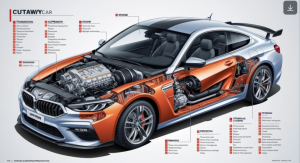
Understanding the different parts of a car is essential for every driver, whether you’re a seasoned motorist or a new car owner. Knowing how each component works can help you maintain your vehicle better, improve performance, and ensure safety on the road. In this comprehensive guide, we’ll break down the key car parts and their functions to give you a clear understanding of what makes your car run smoothly.
1. Engine
The engine is the heart of the car. It converts fuel into mechanical energy to move the vehicle. Most modern cars use internal combustion engines, which burn fuel and air to generate power. Engines can vary in type—such as inline, V-shaped, or electric—but their purpose remains the same: to drive the car forward.
Key Components of the Engine:
- Cylinder block
- Pistons
- Crankshaft
- Camshaft
- Spark plugs (for gasoline engines)
2. Transmission System
The transmission transfers power from the engine to the wheels. It ensures the right amount of power is delivered to the wheels depending on speed and load. There are two main types of transmissions: manual and automatic. In manual cars, the driver shifts gears manually, while automatic cars do this automatically.
3. Braking System
One of the most critical car parts for safety is the braking system. This system allows the driver to slow down or stop the vehicle entirely. Most modern cars come equipped with disc brakes, anti-lock braking systems (ABS), and electronic brake-force distribution (EBD) for improved safety.
Main Brake Components:
- Brake pedal
- Brake pads
- Brake discs/rotors
- Brake calipers
- Brake fluid
4. Suspension System
The suspension system helps maintain vehicle stability and comfort by absorbing road shocks. It ensures that the tires remain in contact with the road surface, which is vital for handling and braking performance.
Major Suspension Parts:
- Shock absorbers
- Struts
- Springs
- Control arms
5. Steering System
The steering system allows the driver to control the direction of the vehicle. It connects the steering wheel to the wheels using various mechanical components. Modern cars often feature power steering or electric power-assisted steering (EPAS) for easier maneuverability.
Steering Components:
- Steering wheel
- Steering column
- Rack and pinion
- Tie rods
6. Exhaust System
The exhaust system carries harmful gases from the engine to the rear of the car, where they are expelled safely. It also reduces engine noise and minimizes pollution through components like the catalytic converter.
Key Exhaust Parts:
- Exhaust manifold
- Catalytic converter
- Muffler
- Tailpipe
7. Fuel System
The fuel system stores and delivers fuel to the engine. Depending on the type of car, this could involve gasoline, diesel, or electricity. In traditional internal combustion vehicles, fuel injectors spray fuel into the combustion chamber where it is ignited.
Fuel System Components:
- Fuel tank
- Fuel pump
- Fuel injectors
- Fuel filter
8. Cooling System
Engines generate heat, and the cooling system helps regulate the engine’s temperature. Without proper cooling, the engine can overheat and get damaged. The system circulates coolant through the engine and radiator.
Cooling Parts:
- Radiator
- Coolant
- Water pump
- Thermostat
- Cooling fans
9. Electrical System
Modern vehicles rely heavily on electronics for everything from starting the engine to operating infotainment systems. The electrical system powers the lights, sensors, battery, and electronic control units (ECUs).
Electrical Components:
- Battery
- Alternator
- Starter motor
- Fuses and relays
- Wiring harness
10. Drivetrain
The drivetrain consists of all the components that deliver power from the engine to the wheels. It includes the transmission, driveshaft, differential, and axles. Depending on the vehicle, it could be front-wheel drive (FWD), rear-wheel drive (RWD), or all-wheel drive (AWD).
11. Body and Frame
The car body is the outer shell that gives the car its shape and protects occupants. Underneath is the frame or chassis, which supports the engine and other components.
Common Body Parts:
- Hood
- Doors
- Fenders
- Bumpers
- Trunk/boot
12. Interior Components
The interior of a car is designed for comfort, control, and entertainment. It includes seats, the dashboard, air conditioning, infotainment systems, and safety features like airbags.
Important Interior Parts:
- Dashboard
- Steering wheel
- Seats
- Seat belts
- Airbags
- Climate control
13. Wheels and Tires
The wheels and tires are the only car parts that make direct contact with the road. Proper tire maintenance is crucial for safety, fuel efficiency, and performance.
Wheel Components:
- Rims
- Tires
- Valve stems
- Lug nuts
14. Lighting System
The lighting system ensures visibility for the driver and makes the vehicle visible to others. It includes headlights, taillights, brake lights, turn signals, and interior lighting.
Lighting Elements:
- Headlights (halogen, LED, or HID)
- Brake lights
- Turn indicators
- Fog lights
- Interior dome lights
15. Safety Features
Modern cars come equipped with advanced safety technologies that go beyond basic mechanical parts. These features are designed to prevent accidents and protect occupants during a crash.
Common Safety Systems:
- Anti-lock Braking System (ABS)
- Electronic Stability Control (ESC)
- Lane Departure Warning
- Blind Spot Monitoring
- Rearview camera
Conclusion
Understanding the parts of a car helps you become a more informed driver and makes it easier to communicate with mechanics, maintain your vehicle, and spot potential issues before they become serious. From the engine and transmission to the suspension and safety systems, each component plays a vital role in the car’s performance, safety, and longevity.
Whether you’re learning for the first time or brushing up your knowledge, keeping these car parts in mind can enhance your driving experience and give you greater control over your vehicle’s health.